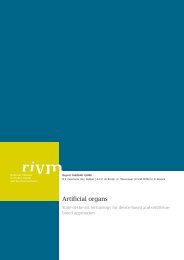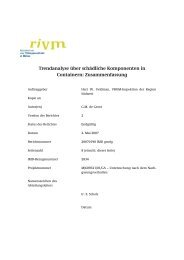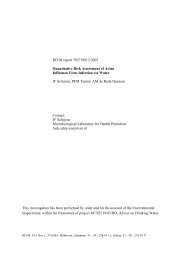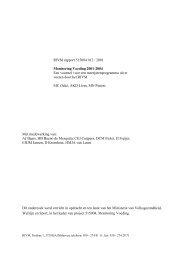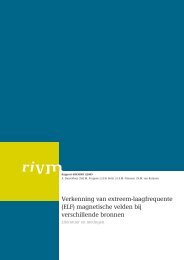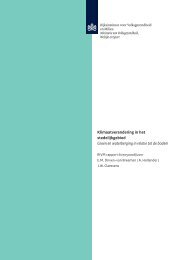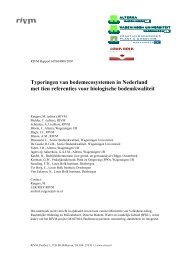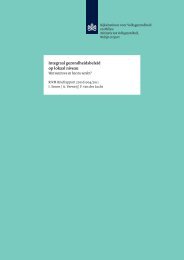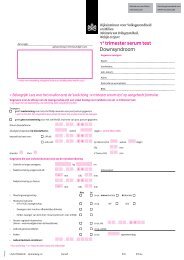Toxicity measurements in concentrated water samples - Rivm
Toxicity measurements in concentrated water samples - Rivm
Toxicity measurements in concentrated water samples - Rivm
Create successful ePaper yourself
Turn your PDF publications into a flip-book with our unique Google optimized e-Paper software.
(VIM, 1996). In analytical chemistry it typically encompasses contributions from sample process<strong>in</strong>g<br />
and treatment (e.g. extraction of the analyte) as well as from <strong>in</strong>strumental read<strong>in</strong>gs.<br />
A target uncerta<strong>in</strong>ty means the measurement uncerta<strong>in</strong>ty that is formulated as a goal and that is decided<br />
on the basis of a specified <strong>in</strong>tended use of measurement results (e.g. like EQS for priority pollutants).<br />
The m<strong>in</strong>imum required relative target uncerta<strong>in</strong>ty for the priority pollutants is set on 50 %.<br />
Knowledge of the magnitude of the contribut<strong>in</strong>g errors from each step or process <strong>in</strong> an analytical<br />
method can be helpful to identify the significant errors to address if action is desirable to reduce the<br />
overall measurement uncerta<strong>in</strong>ty (Lepom et al., 2008). For the method presented here (sampl<strong>in</strong>g,<br />
sample treatment and bioassays), such an approach is not feasible because the composition of the<br />
<strong>samples</strong> by def<strong>in</strong>ition is not known.<br />
An alternative approach of estimat<strong>in</strong>g the measurement uncerta<strong>in</strong>ty is to use data from analysis of<br />
certified reference material, rout<strong>in</strong>e control <strong>samples</strong> or <strong>in</strong>ter laboratory trials. For the XAD-method a<br />
lot is already known about different mixtures of substances (chapter 3) and blanks. The <strong>in</strong>ter laboratory<br />
trial with a field sample gives an <strong>in</strong>dication of the variation <strong>in</strong> test results. Important for this criteria is<br />
the uncerta<strong>in</strong>ty at the level of the concentration factor of the critical value (EC f 50 = 10). To measure the<br />
uncerta<strong>in</strong>ty at this level further <strong>in</strong>tra and <strong>in</strong>ter laboratory surveys should be performed with a known<br />
mixture of substances with a response at the critical level. However every mixture of known substances<br />
will react <strong>in</strong> a different way as a field sample. The response <strong>in</strong> the bioassays of the field <strong>samples</strong><br />
analysed <strong>in</strong> the <strong>in</strong>ter laboratory trial were approximately at the level of C f = 100. The measurement<br />
uncerta<strong>in</strong>ty (CV) at this concentration varied between 5 – 35 %.<br />
6.3 Interpretation of the results<br />
6.3.1 Ruggedness of pT<br />
Aldenberg et al. (2000) tabulated upper, median and lower estimates for the Fraction Affected for<br />
standardized concentrations <strong>in</strong> relation to toxicity data sample size. The <strong>in</strong>terval between the lower and<br />
upper estimate (5 % and 95 % confidence respectively) decreases slightly with <strong>in</strong>creas<strong>in</strong>g number of<br />
toxicity tests (sample size, n). The standardized concentration (-ks), calculated as:<br />
f<br />
log(<br />
C ) − mean<br />
− ks =<br />
standard deviation<br />
Equation 5<br />
has a stronger relation with the confidence <strong>in</strong>terval. This means that the difference between the orig<strong>in</strong>al<br />
<strong>water</strong> sample (C f = 1) and the mean of the SSD-curve determ<strong>in</strong>e the confidence <strong>in</strong>terval together with<br />
the standard deviation of the <strong>samples</strong>. Increas<strong>in</strong>g the number of toxicity tests <strong>in</strong> the sample to estimate<br />
an SSD has therefore only little effect. Only very large sample sizes decrease the confidence <strong>in</strong>terval<br />
substantially.<br />
Standardized concentrations are calculated for monitor<strong>in</strong>g data from 2000-2005 (Figure 6-3). Also for<br />
this data, based on calculations for a s<strong>in</strong>gle fit distribution with Excel, the small effect of <strong>in</strong>creas<strong>in</strong>g the<br />
number of toxicity tests (or sample size = n) on the confidence <strong>in</strong>terval is obvious.<br />
RIVM Report 607013010 79



